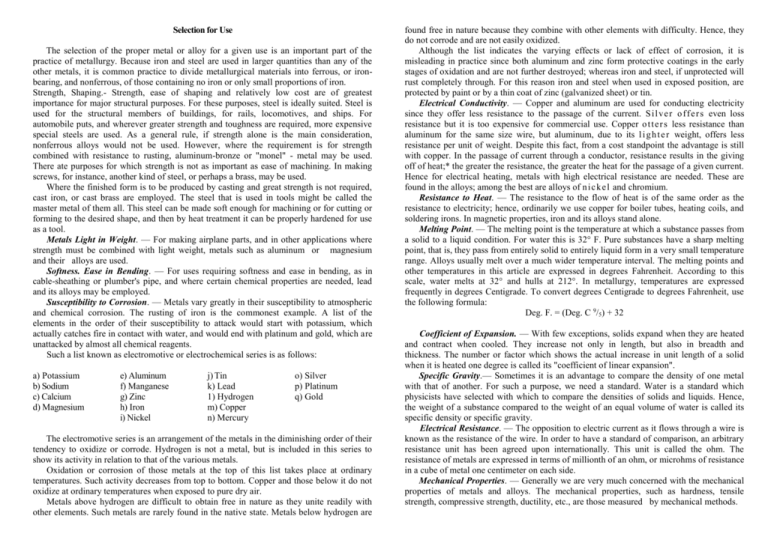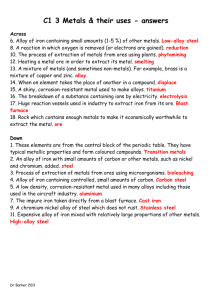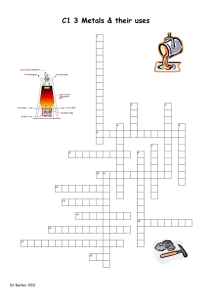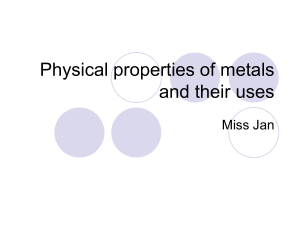Selection for Use
advertisement

Selection for Use The selection of the proper metal or alloy for a given use is an important part of the practice of metallurgy. Because iron and steel are used in larger quantities than any of the other metals, it is common practice to divide metallurgical materials into ferrous, or ironbearing, and nonferrous, of those containing no iron or only small proportions of iron. Strength, Shaping.- Strength, ease of shaping and relatively low cost are of greatest importance for major structural purposes. For these purposes, steel is ideally suited. Steel is used for the structural members of buildings, for rails, locomotives, and ships. For automobile puts, and wherever greater strength and toughness are required, more expensive special steels are used. As a general rule, if strength alone is the main consideration, nonferrous alloys would not be used. However, where the requirement is for strength combined with resistance to rusting, aluminum-bronze or "monel" - metal may be used. There ate purposes for which strength is not as important as ease of machining. In making screws, for instance, another kind of steel, or perhaps a brass, may be used. Where the finished form is to be produced by casting and great strength is not required, cast iron, or cast brass are employed. The steel that is used in tools might be called the master metal of them all. This steel can be made soft enough for machining or for cutting or forming to the desired shape, and then by heat treatment it can be properly hardened for use as a tool. Metals Light in Weight. — For making airplane parts, and in other applications where strength must be combined with light weight, metals such as aluminum or magnesium and their alloys are used. Softness. Ease in Bending. — For uses requiring softness and ease in bending, as in cable-sheathing or plumber's pipe, and where certain chemical properties are needed, lead and its alloys may be employed. Susceptibility to Corrosion. — Metals vary greatly in their susceptibility to atmospheric and chemical corrosion. The rusting of iron is the commonest example. A list of the elements in the order of their susceptibility to attack would start with potassium, which actually catches fire in contact with water, and would end with platinum and gold, which are unattacked by almost all chemical reagents. Such a list known as electromotive or electrochemical series is as follows: a) Potassium b) Sodium c) Calcium d) Magnesium e) Aluminum f) Manganese g) Zinc h) Iron i) Nickel j) Tin k) Lead 1) Hydrogen m) Copper n) Mercury o) Silver p) Platinum q) Gold The electromotive series is an arrangement of the metals in the diminishing order of their tendency to oxidize or corrode. Hydrogen is not a metal, but is included in this series to show its activity in relation to that of the various metals. Oxidation or corrosion of those metals at the top of this list takes place at ordinary temperatures. Such activity decreases from top to bottom. Copper and those below it do not oxidize at ordinary temperatures when exposed to pure dry air. Metals above hydrogen are difficult to obtain free in nature as they unite readily with other elements. Such metals are rarely found in the native state. Metals below hydrogen are found free in nature because they combine with other elements with difficulty. Hence, they do not corrode and are not easily oxidized. Although the list indicates the varying effects or lack of effect of corrosion, it is misleading in practice since both aluminum and zinc form protective coatings in the early stages of oxidation and are not further destroyed; whereas iron and steel, if unprotected will rust completely through. For this reason iron and steel when used in exposed position, are protected by paint or by a thin coat of zinc (galvanized sheet) or tin. Electrical Conductivity. — Copper and aluminum are used for conducting electricity since they offer less resistance to the passage of the current. S i l v e r o ff e r s even loss resistance but it is too expensive for commercial use. Copper o t t er s less resistance than aluminum for the same size wire, but aluminum, due to its l i g h t e r weight, offers less resistance per unit of weight. Despite this fact, from a cost standpoint the advantage is still with copper. In the passage of current through a conductor, resistance results in the giving off of heat;* the greater the resistance, the greater the heat for the passage of a given current. Hence for electrical heating, metals with high electrical resistance are needed. These are found in the alloys; among the best are alloys of n i c k e l and chromium. Resistance to Heat. — The resistance to the flow of heat is of the same order as the resistance to electricity; hence, ordinarily we use copper for boiler tubes, heating coils, and soldering irons. In magnetic properties, iron and its alloys stand alone. Melting Point. — The melting point is the temperature at which a substance passes from a solid to a liquid condition. For water this is 32° F. Pure substances have a sharp melting point, that is, they pass from entirely solid to entirely liquid form in a very small temperature range. Alloys usually melt over a much wider temperature interval. The melting points and other temperatures in this article are expressed in degrees Fahrenheit. According to this scale, water melts at 32° and hulls at 212°. In metallurgy, temperatures are expressed frequently in degrees Centigrade. To convert degrees Centigrade to degrees Fahrenheit, use the following formula: Deg. F. = (Deg. C 9/5) + 32 Coefficient of Expansion. — With few exceptions, solids expand when they are heated and contract when cooled. They increase not only in length, but also in breadth and thickness. The number or factor which shows the actual increase in unit length of a solid when it is heated one degree is called its "coefficient of linear expansion". Specific Gravity.— Sometimes it is an advantage to compare the density of one metal with that of another. For such a purpose, we need a standard. Water is a standard which physicists have selected with which to compare the densities of solids and liquids. Hence, the weight of a substance compared to the weight of an equal volume of water is called its specific density or specific gravity. Electrical Resistance. — The opposition to electric current as it flows through a wire is known as the resistance of the wire. In order to have a standard of comparison, an arbitrary resistance unit has been agreed upon internationally. This unit is called the ohm. The resistance of metals are expressed in terms of millionth of an ohm, or microhms of resistance in a cube of metal one centimeter on each side. Mechanical Properties. — Generally we are very much concerned with the mechanical properties of metals and alloys. The mechanical properties, such as hardness, tensile strength, compressive strength, ductility, etc., are those measured by mechanical methods.





